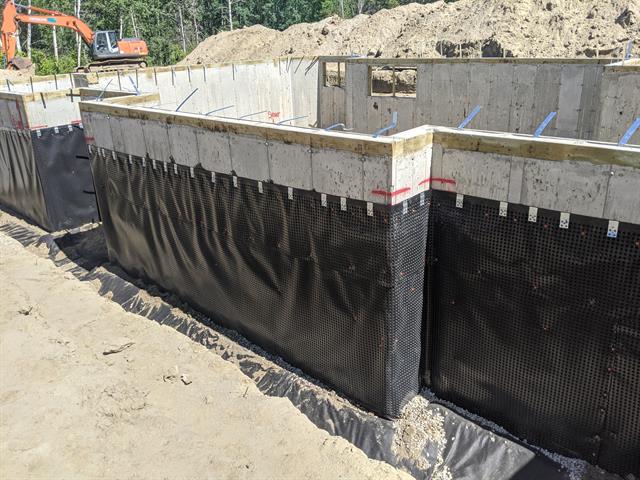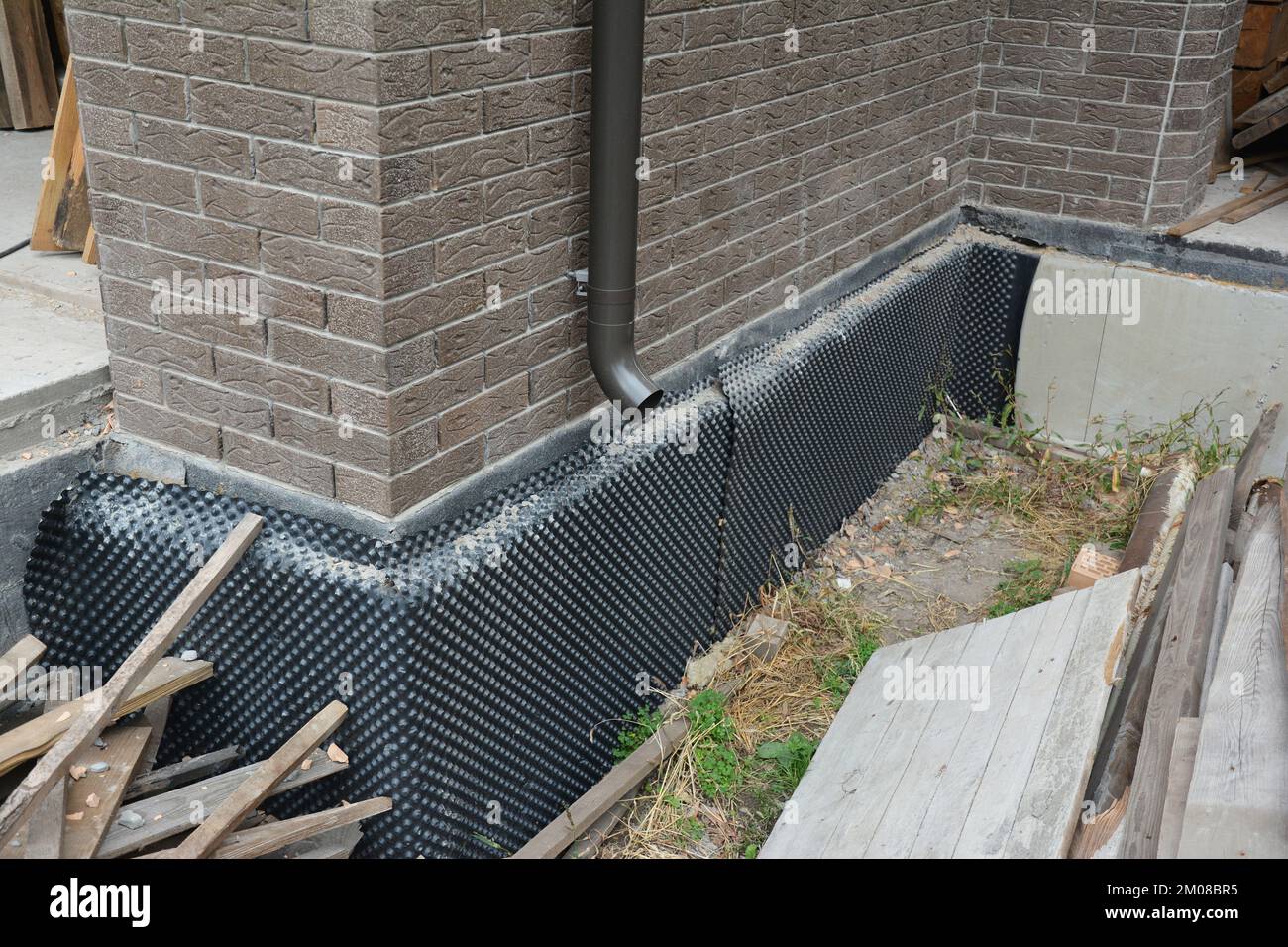Recognizing the Relevance of Damp Proofing in Preventing Structural Damage
Wet proofing functions as a necessary protection versus dampness seepage in buildings. This protective procedure can avoid significant structural damage, yet lots of homeowner continue to be uninformed of its relevance. Recognizing the indications of wetness and understanding the different services offered can be vital. Overlooking damp proofing can lead to severe effects. What are the certain threats and solutions that homeowner should think about?
What Is Damp Proofing and Just How Does It Function?
Moist proofing acts as a necessary barrier versus moisture invasion in buildings. damp proofing newcastle. This process includes using specific products and methods to stop water from penetrating wall surfaces, floorings, and other structural aspects. Usually, wet proofing can be attained through the installment of moist proof membranes, coverings, or making use of specialized sealants.These methods function by developing a safety layer that hinders moisture activity, making certain that the indoor atmosphere remains dry and healthy. Damp proofing is particularly essential in areas vulnerable to high humidity or groundwater, as it helps keep the stability of the framework over time.Moreover, reliable damp proofing adds to power effectiveness by protecting against warm loss connected with moist environments. By attending to prospective moisture concerns prior to they rise, damp proofing offers as a positive step in guarding structures from the harmful effects of water damage, inevitably prolonging their life expectancy and preserving their worth
Typical Indicators of Dampness in a Building
Dampness concerns within a building can materialize via a number of visible signs that suggest the existence of wetness. One famous indication is the look of water spots on wall surfaces or ceilings, which often indicates moisture seepage. In addition, bubbling or peeling paint can recommend that excess moisture is caught underneath the surface area, causing deterioration. An additional typical indicator is the visibility of mold and mildew and mold, which grow in damp conditions and can frequently be recognized by their stuffy smell. Moreover, a surge in humidity degrees can create condensation on home windows and other surface areas, highlighting wetness problems. Warped or unequal floor covering might signify underlying moisture that jeopardizes architectural integrity. Acknowledging these signs early can assist minimize potential damage and maintain a risk-free living atmosphere. Routine evaluations and prompt activity are vital in dealing with wetness problems prior to they escalate.
The Risks of Ignoring Damp Proofing
Disregarding wet proofing can cause significant threats to a structure's architectural honesty, as moisture accumulation may damage walls and structures. Furthermore, long term moisture produces a setting for mold and mildew growth, posturing serious carcinogen to passengers. Addressing these risks is important for making sure both security and durability of the residential or commercial property.
Structural Stability Risks
They expose their residential properties to substantial architectural honesty hazards when property owners neglect the value of effective wet proofing. Extended wetness seepage can bring about the advancement of mold and mildew, which weakens fundamental elements and can compromise total security. Additionally, excess moisture can wear down concrete and brickwork, resulting in fractures and architectural failures. Wood components are particularly vulnerable; they can rot and shed load-bearing capability, positioning severe risks to the structure's structure. Without treatment moist conditions might draw in parasites, such as termites, which better intensify structural wear and tear. Eventually, disregarding moist proofing actions can cause costly repair work and possible safety hazards, emphasizing the crucial role of positive wet administration in preserving the stability of domestic homes.
Health And Wellness Hazard Concerns
Just how can an apparently minor oversight result in serious health and wellness risks? Ignoring wet proofing can produce an environment conducive to mold and mildew development, which poses significant health and wellness hazards. Mold and mildew spores can trigger allergies, breathing problems, and various other wellness problems, particularly in prone populaces such as children, the elderly, and individuals with pre-existing conditions. In addition, relentless moisture can draw in pests like rodents and pests, which bring illness that better jeopardize wellness. The existence of dampness additionally adds to a decrease in interior air high quality, aggravating asthma and other respiratory disorders. The failing to attend to damp issues not only endangers architectural integrity yet also jeopardizes the well-being of residents, highlighting the crucial need for reliable wet proofing steps.
Various Types of Damp Proofing Solutions
Various aspects can contribute to damp problems in structures, choosing the ideal wet proofing option is crucial for maintaining architectural honesty. Several choices are available, each customized to certain conditions.One common option is a damp-proof membrane layer (DPM), normally constructed from polyethylene or asphalt, which is set up in walls and floors to stop dampness ingress. One more choice is damp-proof courses (DPC), which are layers of waterproof material placed within walls to obstruct increasing damp.Chemical damp proofing involves injecting waterproofing chemicals right into walls to produce a barrier against dampness. Furthermore, external treatments such as tanking, which entails using a water resistant layer to the here outside of foundations, can be effective in protecting against water penetration.Each remedy has its advantages and is selected based upon the structure's certain problems, environmental problems, and long-lasting maintenance considerations, guaranteeing perfect defense versus damp-related damages.

The Expense of Damp Damage vs. Prevention
Recognizing the monetary ramifications of wet damages compared to avoidance highlights the value of proactive procedures. The expenses connected with wet damage can be substantial, consisting of repairs to architectural components, mold and mildew remediation, and prospective health-related expenditures. House owners may face significant monetary stress if comprehensive damage occurs, resulting in increased insurance costs and shed residential property value.In comparison, purchasing damp proofing solutions is normally even more cost-effective. First costs for prevention methods, such as mounting damp-proof membrane layers or enhancing drainage systems, are typically outweighed by the long-lasting cost savings from preventing pricey repair services. Additionally, avoiding moist issues can improve a residential property's overall worth and allure, making it a smart financial investment. When evaluating the expense of wet damages versus prevention, it ends up being clear that taking positive steps can protect monetary interests and keep the honesty of the residential or commercial property with time.
Choosing the Right Damp Proofing Approach for Your Residential property
Which damp proofing technique is most appropriate for a specific residential property frequently relies on different variables, consisting of the structure's age, existing wetness issues, and neighborhood ecological conditions. For older structures, standard techniques such as asphalt membrane layers or cementitious coverings may be more effective, as they can supply a durable barrier against climbing damp. In contrast, more recent structures could gain from modern-day solutions like infused damp-proof courses, which are less invasive and can be tailored to specific wetness challenges.Additionally, properties in areas with high water tables or hefty rainfall might call for advanced techniques, such as cavity wall surface water drainage systems or exterior waterproofing. Home owners ought to also consider the specific products made use of in their structure's building and construction, as some techniques might not be suitable. Ultimately, a detailed evaluation by a professional can guide residential property owners in choosing the most reliable damp proofing method tailored to their special scenarios.
Preserving Your Damp Proofing System With Time
Routine upkeep of a wet proofing system is crucial for guaranteeing its lasting effectiveness and shielding a home from moisture-related damage. Homeowner ought to carry out regular evaluations to determine any indicators of wear or concession in the moist proofing layer. This includes monitoring for fractures, peeling off paint, or mold and mildew growth, which might show dampness intrusion.Additionally, it is advisable to tidy gutters and downspouts routinely to stop water buildup around the structure. If damage is observed.Engaging professional services for periodic analyses can better improve the sturdiness of the system, reapplying membranes or sealers might be needed. These experts can supply understandings into possible vulnerabilities and recommend timely fixings.
Often Asked Questions
How Much Time Does Damp Proofing Therapy Last Before Requiring Repairs?
The longevity of damp proofing treatment usually ranges from 10 to thirty years, relying on elements such as the method made use of, ecological conditions, and upkeep methods. Normal assessments can aid determine when repair services may be needed.
Is DIY Damp Proofing Effective Compared to Specialist Providers?
The efficiency of DIY damp proofing differs significantly. damp proofing newcastle. While some individuals may achieve adequate outcomes, professional services normally guarantee comprehensive remedies, leveraging experience and top quality materials to protect against future problems much more accurately than the majority of do it yourself attempts
Can Damp Proofing Improve Indoor Air High Quality?
The inquiry of whether damp proofing can boost indoor air high quality emerges regularly. Efficient moist proofing decreases moisture degrees, consequently minimizing mold development and irritants, inevitably adding to a much healthier indoor atmosphere for passengers.
Are There Particular Regulations for Damp Proofing in Various Locations?
Laws for damp proofing vary by region, frequently affected by neighborhood building codes and environmental conditions. Compliance guarantees reliable dampness control, protecting structures and promoting safety and security, which highlights the requirement for adherence to these particular policies.

What Are the Long-Term Perks of Proper Damp Proofing?
The long-lasting benefits of appropriate moist proofing consist of enhanced structural honesty, minimized upkeep costs, enhanced indoor air quality, and raised building worth. These advantages add to a much healthier living atmosphere and long term life-span of structures. Generally, moist proofing can be attained via the installation of moist proof membranes, finishings, or the use of specialized sealants.These techniques function by creating a safety layer that prevents moisture movement, making sure that the indoor setting remains healthy and balanced and dry. Damp proofing is particularly essential in locations vulnerable to high humidity or groundwater, as it assists keep the honesty of the framework over time.Moreover, reliable moist proofing contributes to power performance by protecting against warm loss connected with wet environments. Overlooking wet proofing can lead to considerable dangers to a building's structural stability, as wetness accumulation may deteriorate wall surfaces and foundations (damp specialist newcastle). Various aspects can add to damp concerns in structures, choosing the appropriate moist proofing service is essential for maintaining structural honesty. Which moist proofing technique is most ideal for a certain home frequently depends on various variables, including the building's age, existing dampness issues, and regional environmental problems